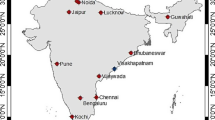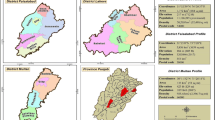Abstract
Land-cover change is the main factor of Land Surface Temperature (LST) variation in urban areas. The temperature of man-made classes within cities is normally higher than natural classes in the surrounding areas which leads to the Urban Heat Island (UHI) phenomenon. In this study, LST maps of three cities (i.e. Paris, Riyadh and Manama) are analyzed to investigate how SUHI reacts in different cities. The SUHI intensity during summer and winter is also assessed to understand the seasonal changes of SUHI. The Advanced Very High Resolution Radiometer (AVHRR) images have been used as the main data source for investigating temperature variability in the urban areas. However, in order to define different types of land-cover and correlate those with AVHRR pixel values, one of Landsat sensors have also been used in each case. These include Thematic Mapper, Enhanced Thematic Mapper or Operational Land Imager, depending on their synchronization with the AVHRR images. The analysis of the temperature variation showed that the behavior of SUHI is not the same in different cities and is dependent on the land-covers surrounding the city.





Similar content being viewed by others
References
Becker, F., & Li, Z. L. (1990). Towards a local split window method over land surface. International Journal of Remote Sensing, 11, 369–393.
Caselles, V., Coll, C., & Valor, E. (1997). Land surface emissivity and temperature determination in the whole HAPEX-Sahel area from AVHRR data. International Journal of Remote Sensing, 18, 1009–1027.
Cihlar, J., Ly, H., Li, Z., Chen, J., Pokrant, J., & Huang, F. (1997). Multitemporal, multichannel AVHRR data sets for land biosphere studies-artifacts and corrections. Remote Sensing of Environment, 60, 35–57.
Dousset, B., & Gourmelon, F. (2003). Satellite multi-sensor data analysis of urban surface temperatures and landcover. Photogrammetry & Remote Sensing, 58, 43–54.
Fabrizi, R., Bonafoni, S., & Biondi, R. (2010). Satellite and ground-based sensors for the urban heat island analysis in the city of Rome. Remote Sensing, 2, 1400–1415.
Garner, R. (2016). Landsat 8 Instruments | NASA. April 28. https://www.nasa.gov/content/landsat-8-instruments.
Ghosh, R., Shahjahan Ali, M., Hena, A., and Rahman, H. (2012) A simple cloud detection algorithm using NOAA-AVHRR satellite data. International Journal of Scientific & Engineering Research, 3(6).
Hamdi, R. (2010). Estimating urban heat island effects on the temperature series of uccle (Brussels, Belgium) using remote sensing data and a land surface scheme. Remote Sensing, 2, 2773–2784.
Hu, Y., & Gensuo, J. (2010). Influence of land use change on urban heat island derived from multi-sensor data. International Journal of Climatology, 30, 1382–1395.
Hubanks, Paul. (2015). MODIS atmosphere QA plan for collection 006. Greenbelt, MD: NASA Goddard Space Flight Center.
Imhoff, M. L., Zhang, P., Wolfe, R., & Bounoua, L. (2010). Remote sensing of the urban heat island effect across biomes in the continental USA. Remote Sensing of Environment, 114, 504–513.
Kerr, Y. H., Lagouarde, J. P., Nerry, F. and Ottlé, C. (2005) Land surface temperature retrieval techniques and applications. In: A. Q. Dale, C. L. Jeffrey (Eds.), Thermal remote sensing in land surface processes. Taylor & Francis e-Library.
Kidwell, K. (2008). NOAA polar orbiter data user’s guide section 3.3. NOAA National Climatic Data Center. http://www.ncdc.noaa.gov/oa/pod-guide/ncdc/docs/podug/html/c3/sec3-3.htm. Accessed 14 Nov 2016.
Lahraoua, M., Raissouni, N., Chahboun, A., Azyat, A., & Achhab, N. B. (2013). Split-Window LST Algorithms Estimation From AVHRR/NOAA Satellites (7, 9, 11, 12, 14, 15, 16, 17, 18, 19) Using Gaussian Filter Function. International Journal of Information & Network Security (IJINS), 2, 403–412.
Liu, L., & Zhang, Y. (2011). Urban heat island analysis using the landsat TM data and ASTER data: a case study in Hong Kong. Remote Sensing, 3, 1535–1552.
Masek, J. G., Honzak, M., Liu, S., Goward, P. N., & Pak, E. (2001). Landsat-7 ETM + as an observatory for land cover Initial radiometric and geometric comparisons with Landsat-5 Thematic Mapper. Remote Sensing of Environment, 78, 118–130.
Poli, G., Adembri, G., Gherardelli, M. & Tommasini, M. (2010) Dynamic threshold cloud detection algorithm improvement for AVHRR and SEVIRI images. In Geoscience and remote sensing symposium (IGARSS). Honolulu, HI.
Poxo Vhquex, D, Olmo Reyes, F. J., and Alados Arboledas, L. (1997) A comparative study of algorithms for estimating land surface temperature from AVHRR Data. Remote Sensing of Environment, 62(3), 215–222.
Prata, A. J., and Platt, C.M.R. (1991). Land surface temperature measurements from the AVHRR. In 5th AVHRR data users meeting. Tromso, Norway.
Price, J. C. (1984). Land surface temperature measurements from the Split Window channels on the NOAA 7 advanced very high resolution Radiometer. Journal of Geophysical Research, 89, 7231–7237.
Pu, R., Gong, P., Michishita, R., & Sasagawa, T. (2006). Assesment of multi-resolution and multi-sensor data for urban surface temperature retrieval. Remote Sensing of Environment, 104, 211–225.
Rasul, A., Balzter, H., & Smith, C. (2015). Spatial variation of the daytime surface urban cool island during the dry season in Erbil, Iraqi Kurdistan, from Landsat 8. Urban Climate, 14, 176–186.
Rinner, C., & Hussain, M. (2011). Toronto’s urban heat island—exploring the relationship between land use and surface temperature. Remote Sensing, 3, 1251–1265.
Robel, J. (2009). The NOAA KLM User’s Guide Section 3.1. NOAA National Climatic Data Center. March 03. http://www.ncdc.noaa.gov/oa/pod-guide/ncdc/docs/klm/html/c3/sec3-1.htm.
Sobrino, J. A., Jiménez-Muñoz, J. C., Sòria, G., Romaguera, M., Guanter, L., & Moreno, J. (2008). Land surface emissivity retrieval from different VNIR and TIR sensors. IEEE Transactions on Geoscience and Remote Sensing, 46, 316–327.
Sobrino, J. A., & Raissouni, N. (2000). Toward remote sensing methods for land cover dynamic monitoring. Application to Morocco. International Journal of Remote Sensing, 20(2), 353–366.
Sobrino, J. A., Jimenez-Munoza, J. C., & Paolini, L. (2004). Land surface temperature retrieval from LANDSAT TM 5. Remote Sensing of Environment, 90(4), 434–440.
Trishchenko, A. P., & Li, Z. (2001). A method for the correction of AVHRR onboard IR calibration in the event of short-term radiative contamination. International Journal of Remote Sensing, 22(17), 3619–3624.
Valor, E., & Caselles, V. (1996). Mapping land surface emissivity from NDVI application to European, African, and South American Areas. Remote Sensing of Environment, 57, 167–184.
Wilson, J. S., Clayb, M., Martina, E., Stuckeyc, D., & Vedder-Risch, K. (2003). Evaluating environmental influences of zoning in urban ecosystems with remote sensing. Remote Sensing of Environment, 86(3), 303–321.
2016. http://www.climatemps.com/. Accessed 14 Nov 2016.
Zhu, Shan-You, Yin, Qiu, & Kuang, Ding-Bo. (2006). Using characteristic spectral bands of OMIS1 imaging spectrometer to retrieve urban land surface temperature. International Journal of Remote Sensing, 27(8), 1661–1676.
Author information
Authors and Affiliations
Corresponding author
About this article
Cite this article
Sherafati, S., Saradjian, M.R. & Rabbani, A. Assessment of Surface Urban Heat Island in Three Cities Surrounded by Different Types of Land-Cover Using Satellite Images. J Indian Soc Remote Sens 46, 1013–1022 (2018). https://doi.org/10.1007/s12524-017-0725-3
Received:
Accepted:
Published:
Issue Date:
DOI: https://doi.org/10.1007/s12524-017-0725-3




